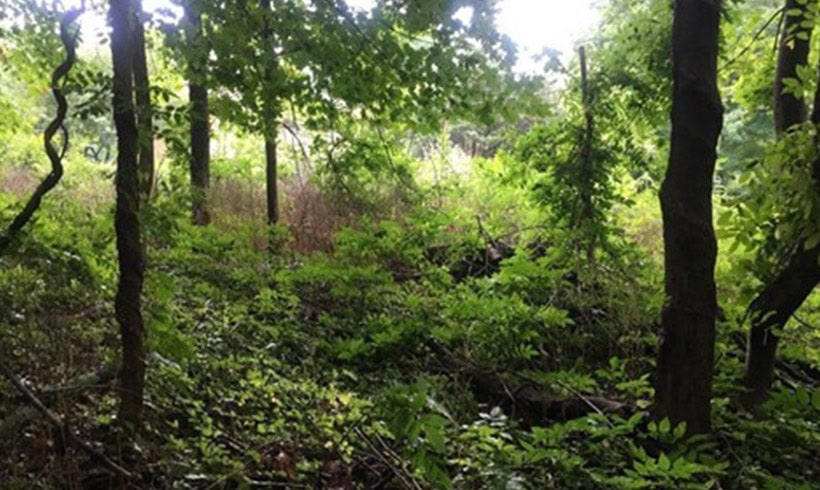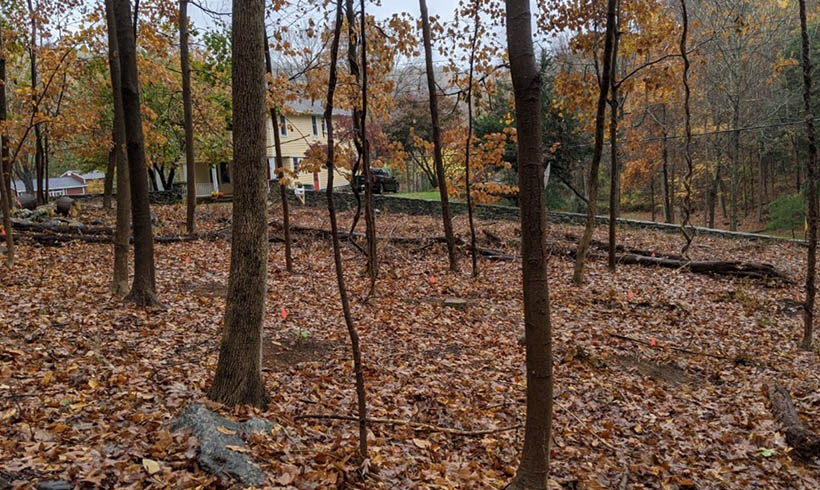Oak Restoration Project
This project aims to use densely planted native oak saplings to restore a once heavily invaded area.
Before the start of this project, the site was overrun with tree-of-heaven, wisteria, oriental bittersweet, and Japanese honeysuckle. Tree-of-heaven is a preferred host plant for the invasive Spotted Lanternfly which is threatening the Lower Hudson Valley. By removing its preferred hosts, we may be able to delay or prevent the establishment of this devastating insect. The tree-of-heaven was treated and removed from the site, and some of the large wisteria vines were mechanically removed by hand in late summer 2020. In their place, over 120 native tree saplings were planted and protected with tree tubes. Species planted included red oak, bear oak, sugar maple, and American elm were planted.

Before restoration

After restoration
In fall 2021, chinkapin oak and bear oak will be planted to replace any trees that did not survive winter. Additionally, common ninebark (a native shrub) will be planted closer to the road to help shade out plants under the power lines. The site will be closely monitored, and regrowth of invasive plants will be cut back regularly over the next 3-5 years. As trees begin to mature, they will be thinned so they are appropriately spaced. Once this project is established, there will be educational workshops with local land managers to discuss this method of site restoration. This project was funded through a grant awarded by an anonymous foundation.
FAQ
Why do you use tree tubes? What is the netting on top of them for?
Tree tubes help protect the trees from deer browse, while also filtering out some of the harsh direct sunlight and trapping in humidity to increase growth rate. The netting on top of the tubes prevents birds from accidentally going inside and getting stuck. Once the saplings are established, the tree tubes can be removed and reused at a different planting site.
What is Spotted Lanternfly and why do want to avoid it from establishing?
Spotted lanternfly is an insect that was accidently introduced to Pennsylvania in 2014 on shipping equipment. Because it is native to China, Bangladesh, and Vietnam, it has no natural predators in the northeast. Once established, each insect can lay 30-50 eggs, and contribute to tree dieback by defoliating all the leaves on their host trees by eating the leaves. This insect also has a large impact on farming so containing the spread is important for preserving local agriculture. If you think you see one, please report to the NYS Department of Conservation: https://www.dec.ny.gov/animals/113303.html
Why did you plant so many trees if you’re just going to thin them out later? Why so many oaks?
By planting so many trees initially, we’re able to heavily shade the ground and reduce the growth rate of the invasive species at the site. Overplanting also lets us choose to keep the trees that are best adapted to the site once they are established. Oak trees were primarily planted because they have high ecological value by producing acorns, and they are starting to disappear from our landscape. To preserve oaks, we need to start planting and protecting young trees.

